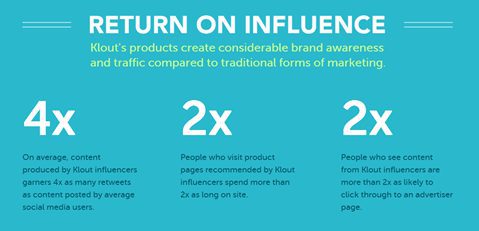Klout Is the Most Interesting Company on the Planet, and Here’s Why
I just finished reading Return on Influence by Mark Schaefer (his blog), which focuses a good portion of its pages on the rising importance of social scoring and, specifically, the Klout platform, and its potential impacts not only to corporate and professional marketing, but on the way we capture, analyze, and consume data about our many networks – whether they be networks (or circles) of customers, employees, partners, or friends. I’ll dive more deeply into the book itself in a future post, but want to instead capture a few of my key takeaways of this must-read for modern corporate enthusiasts.
Just to clarify – social scoring is not just about tracking the number of tweets or followers of an individual. Klout manages more than 100 different data points within their algorithms, and is constantly refining and changing those algorithms based on what they learn from the data, and as network patterns ebb and flow. While there is still the occasional mistake – such as associating the topic of My Little Pony to a technology professional like Seb Matthews (this is my attempt, by linking his name to the topic, to get My Little Pony to show up in his Klout profile ![]() ) – the platform is rapidly improving, and the applications of these scoring mechanisms are countless.
) – the platform is rapidly improving, and the applications of these scoring mechanisms are countless.
About my title to this post: I really do think that what Klout is working to perfect is one of the most important technologies we’ve ever seen, with the potential to revolutionize sales, commerce, marketing, people management, and more.
Social scoring will one day become as ubiquitous as maps have become to mobile phones. You just expect them to be there, and regardless of the brand providing the tools, you expect them to work in a certain way, and to get you from point A to point B (unless driving in downtown Boston, in which case maps don’t work. It’s the Bermuda Triangle of GPS devices). However, as I wrote about in a previous post, social scoring is just one data point (or set of data points) and like any data analysis effort, should be combined with other data and resources, online and offline, to paint a more complete picture of a user, or of a company or product. Call it “analytics triangulation,” if you will.
My reading habits may seem eclectic to some, but I really do try to suck every useful morsel out of the business and marketing books I read, as illustrated in the image above. As I read, I mark up, annotate, and dog-ear pages that have actionable ideas that I want to follow up on. As you can see from the image, I had quite a few takeaways from Return on Influence as I was sitting on airplanes these last two weeks, and started jotting down ideas for ways that social scoring could change a number of different products and services…..only to find that many of the ideas I had reached were shared by others, and captured in the final chapter of the book. For example, Robert Scoble (@scobleizer) shares his thoughts on connecting online and offline behaviors, making social scoring a powerful potential solution for test marketing a product. The author shares his thoughts around social scoring’s logical fit with customer relationship management platforms – which was where my thoughts were going, as well.
Think of what you could get with Klout integration with Salesforce or Dynamics CRM, allowing you to capture influence metrics for companies, brands, and individuals  associated with them. You could then create lead generation and email campaign strategies focusing on key influencers or with people that have influence over combinations of topics – like SharePoint and Yammer, or Seb Matthews and My Little Pony (attempt #2). You’ll be able to better target your marketing efforts toward those users with the greatest likelihood to take action: to forward it, blog about it, buy it, recommend it, or to come into the brick and mortar store.
associated with them. You could then create lead generation and email campaign strategies focusing on key influencers or with people that have influence over combinations of topics – like SharePoint and Yammer, or Seb Matthews and My Little Pony (attempt #2). You’ll be able to better target your marketing efforts toward those users with the greatest likelihood to take action: to forward it, blog about it, buy it, recommend it, or to come into the brick and mortar store.
Think of how this kind of data analysis might fit into the corporate world: analyze how users collaborate, how they participate in social networks inside and outside the company, and then use that data to develop gamification strategies to further encourage the right behaviors, and to build a more compelling, engaging environment. Watching the trending data around how people are dogfooding your own products (the practice of using your own software/solutions before shipping to customers) will show you what is working, and where future customer pains may arise.
Another application might be augmenting (or replacing) the annual review process, basing raises, rewards, and recognition on social scores – assuming there was a blending of online and offline data points, such as 360 degree feedback. This might go a long way into fixing the sometimes perceived (but mostly real) problems with fiefdom-building, favoritism, and high-quality employees being overlooked because they just don’t do enough “managing up.”
Social scoring is a fascinating space, and one which is growing rapidly. Schaefer includes a list of related companies at the back of his book, and explains their value add. I’ve been checking out a few of them (you may have seen my tweets), and not all are up and working – fewer more look to provide any real value. But I’ll keep testing the waters, and will share my findings.
And if you’d like to see my Klout profile (hovering around 72 right now), you’ll find my page here.







Great post. I’ve thinking for some time about the Microsoft partner network and how social scoring might be important in the future. I’ve been trying to setup an alternative index of MS partners (www.partnerpulse.co) and one area where I think it could have a real use is in this area of social scoring.
Maybe I could create my own score for partners (based on MS partner specifics like competencies, as well a Twitter et al), or maybe I could use a service like Klout. This begs the question.. is a companies Klout score important, or some kind of combined score from employees Klout numbers.
Personally I think there is definitely something in this, just not nailed it down exactly just yet!
See Kred’s scoring process that competes with Klout – http://www.socialmediadelivered.com/2012/04/18/infographic-klout-vs-kred/
Another post on Kred vs Klout – http://www.forbes.com/sites/scottlevy/2013/03/04/klout-vs-kred-which-if-any-is-better-for-your-business/
I like Kred’s ‘open transparency’ approach and having competing approaches is quite possibly the best way for the market.
Which is why I am very interested to see their business offering, and how they extend their expertise into the realm of closed (internal) data.
While I agree with you that the sources of data are critical — good data in, potential for good output is high — but would argue that most secondary data is always in a state of flux. Primary data (user profile, demographics, machine data) is fairly consistent, but the interesting data coming from those ‘100 points of light’ matched against that primary data is what makes it all interesting, what helps you slice and dice that primary data, and look at it in new and different ways.
Knowing that this secondary data will constantly change is what allows us to better map the changing habits and attitudes of our end users. If you look at the realm of online analytical processing vendors, the players who are best at the visualization of data are the winners.
Klout does have the right idea but I think it’ll be difficult to achieve a lasting goal as they’ll always be in a state of flux. As your post points out – they manage over 100 data points within their algorithms which they are constantly refining & changing. The weakness lies not in the representation of the networks (a graph theory application) but from the different sources that provide the attributes to the nodes & edges of the networks that Klout interprets to give its K-Index. These network sources – e.g., Facebook, Twitter, InstaGram, LinkedIn, G+, etc. vary by the information they provide (via their API). In certain sources, e.g. Pinterest – this information is not available at all and yet, Pinterest is one of the leading socal media network, particularly with women (~70% users) whose absence in the Klout-index would make the index less than optimal. In another example, LinkedIn illustrates (graphically), a LinkedIn user’s graph network – this application ‘InMaps’ uses internal data that’s not readily available to Klout (yet).
So, it’s a right idea but it remains to be seen how well the K-Index will truly represent the social media network users’ klout.
I think the main issue people have with the platform are questionable topics. Klout has acknowledged some issues with there model around topic suggestions, and are working on it. But I don’t think that one feature negatively impacts other aspects of their algorithm…but its certainly something they are trying to address, and then o build confidence.
After that, people did complain a lot when they experienced an early algorithm reconfiguration, and some people experienced a dramatic drop (and some climbed). That did not do too much for confidence. But people need to understand — and what Schaefer points out in the book — is that there are almost daily changes to the algorithm. It’s constantly being refined.
Now, as for stats in general, you also have to remember that much of it is more art than science. A slice of data at a single point in time is much less useful than looking at that data trending over time, and in correlation to other data. Movement up or down based on activity is a much better stat than your Klout score itself, in my opinion.
This is just really fascinating data to have, both externally through a site like Klout, and eventually behind the firewall.
While I understand what Klout is trying to do … they are a LONG, LONG way from where they need to be.
I agree with your points about Mark Schaefer’s book “Return on Influence” as he is a smart guy by riding this wave of influence. He’s on the right track.
It will be an interesting experiment here to see if you klout score changes.